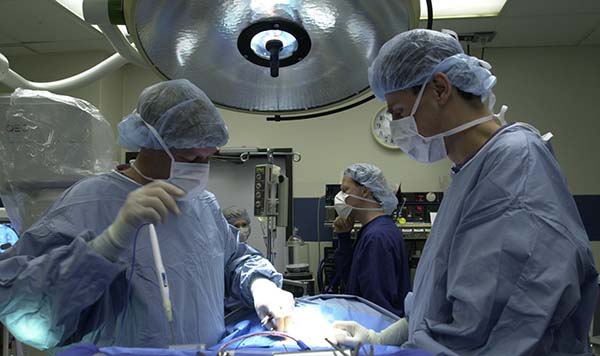Sciatica Surgery
Surgery for sciatica is performed in order to remove the pressure on the sciatic nerve that may be caused by a herniated disc, degenerative disc disease, bone spurs, scar tissue, or spinal stenosis. When people complain of low back pain, they often say they have sciatica. However, sciatica is not a condition on its own, but a collection of symptoms that can be caused by various lumbar spine conditions. It is often described as mild to severe pain in the right or left leg, radiating pain down the extremities on the side affected, shooting pain, sudden stabbing pain as well as tingling, numbness, and muscle weakness. It is caused by compression of one or more of the nerves in the lower back as they leave the spinal canal.

What Causes Sciatic Nerve Compression
Several disorders can cause sciatic nerve compression that results in sciatica symptoms. In most cases, the level of pain or discomfort changes as patients change positions, but constant, chronic pain is also a possibility. The most common causes include:
- Degenerative disc disease
- Spinal Stenosis
- Pinched nerve
- Herniated disc
- Bulging disc
- Bone spurs
- Spondylolisthesis
- Trauma
- Piriformis syndrome
- Cauda equina syndrome
When is Sciatica Surgery Done
Sciatica surgery is performed to help manage the symptoms of chronic sciatic nerve compression. These symptoms generally include low back pain, pain that radiates down the buttocks, legs, or feet, and tingling and numbness in the lower extremities. Patients may have a combination of any of these symptoms.
When conventional sciatica treatment, which may include non-steroidal anti-inflammatory drugs (NSAIDs), physical therapy and/or chiropractic spinal adjustments, fails to provide relief, surgery may be required.
The surgery provides sciatic pain relief by relieving pressure on the nerve roots and nerves as they exit the spinal canal.
Who Is a Candidate for the Procedure
If you have leg pain that has persisted for more than six weeks, puts limitations on your ability to participate in everyday activities, and is not relieved by non-surgical, conservative sciatica treatments such as non-steroidal anti-inflammatory medication, oral steroids, manual manipulation, and/or physical therapy, you may be a candidate for surgical intervention.
Many patients respond well to non-surgical treatments, however, there are some situations in which spine surgery is a better option, including:
- Bowel or bladder dysfunction
- Spinal stenosis
- Neurologic dysfunctions
- Acute/chronic symptoms that haven’t responded to non-surgical treatment
- Decreased quality of life
The Bonati Spine Procedures for Sciatica
The Bonati Spine Procedures are safe and highly effective alternative to traditional open back surgery and spinal fusion. They achieve excellent results in decompressing nerves to treat sciatica and many other spinal conditions. The goal of surgery for the treatment of sciatica is to remove the pain by resolving the underlying problem which is putting pressure on the sciatic nerve. The Bonati Spine procedures utilize an array of procedures to treat sciatica, which may include:
Discectomy
A discectomy is a procedure in which a part of a herniated or bulging disc is removed to relieve pressure on the nerves and nerve roots.
Foraminotomy/Foraminectomy
A foraminotomy/foraminectomy is a decompression surgery that involves the removal of bone or tissue that is obstructing the neuroforamen and compressing the nerve s and/or nerve roots.
Laminectomy/Laminotomy
Both of these procedures involve removing a part of the spine called the lamina. They are designed to decompress the spinal nerve roots or spinal cord by widening the spinal canal.
Before Surgery
Prior to surgery, your physician will ask you to stop taking specific medicines, including:
- Ibuprofen (Motrin, Advil)
- Aspirin
- Naproxen (Naprosyn, Aleve)
If you have heart disease, diabetes, or other medical conditions, you may be required to obtain a medical clearance form from your treating physician. You should also discuss with your physician or spine surgeon all the medications you are currently taking and which, if any, you should still take on the day of the surgery, and which you should not.
On the Day of the Surgery
- Do not eat or drink 6-12 hours prior to the procedure
- Use small sips of water to take any medicines your physician has recommended you continue taking
- Arrive on time
These are general guidelines, every person and every case is different. Be sure to follow all instructions given to you by your doctor and/or surgeon prior to and on the day of your surgery.
During Surgery
The Bonati Spine institute does not use general anesthesia. All surgical procedures involve conscious IV sedation and local anesthesia so that patients are comfortable and able to provide feedback during the procedure. While in the operating room, the surgical team will test and confirm that patients can complete a series of mobility exercises.
After Surgery
After surgery, patients are moved to the post-operative care unit for observation and rest. They will have a consultation with their spine surgeon to determine if they need any additional procedures. Follow-up surgeries, if needed, are usually scheduled within a few days of the first surgery so that the swelling from the first procedure can subside. Patients will be given a regimen of walking therapy.
Recovery Time from Sciatica Surgery
Due to the smaller incision causing less damage to the tissues surrounding the spine, The Bonati Spine Procedures have a shorter, much less painful recovery. After a few days, office workers can return to work. For more active jobs, a return to full-time work is usually achieved after a few weeks. These are estimates as every patient recovers at a different rate. However, the recovery time for traditional open back surgery can take 3 months or longer.
The success rate for sciatica at The Bonati Spine Institute is very high. The Bonati Spine Institute has achieved a 98% patient satisfaction rate. To learn more about how we may be able to help treat your sciatic pain, please contact our Tampa, FL spine center location.
